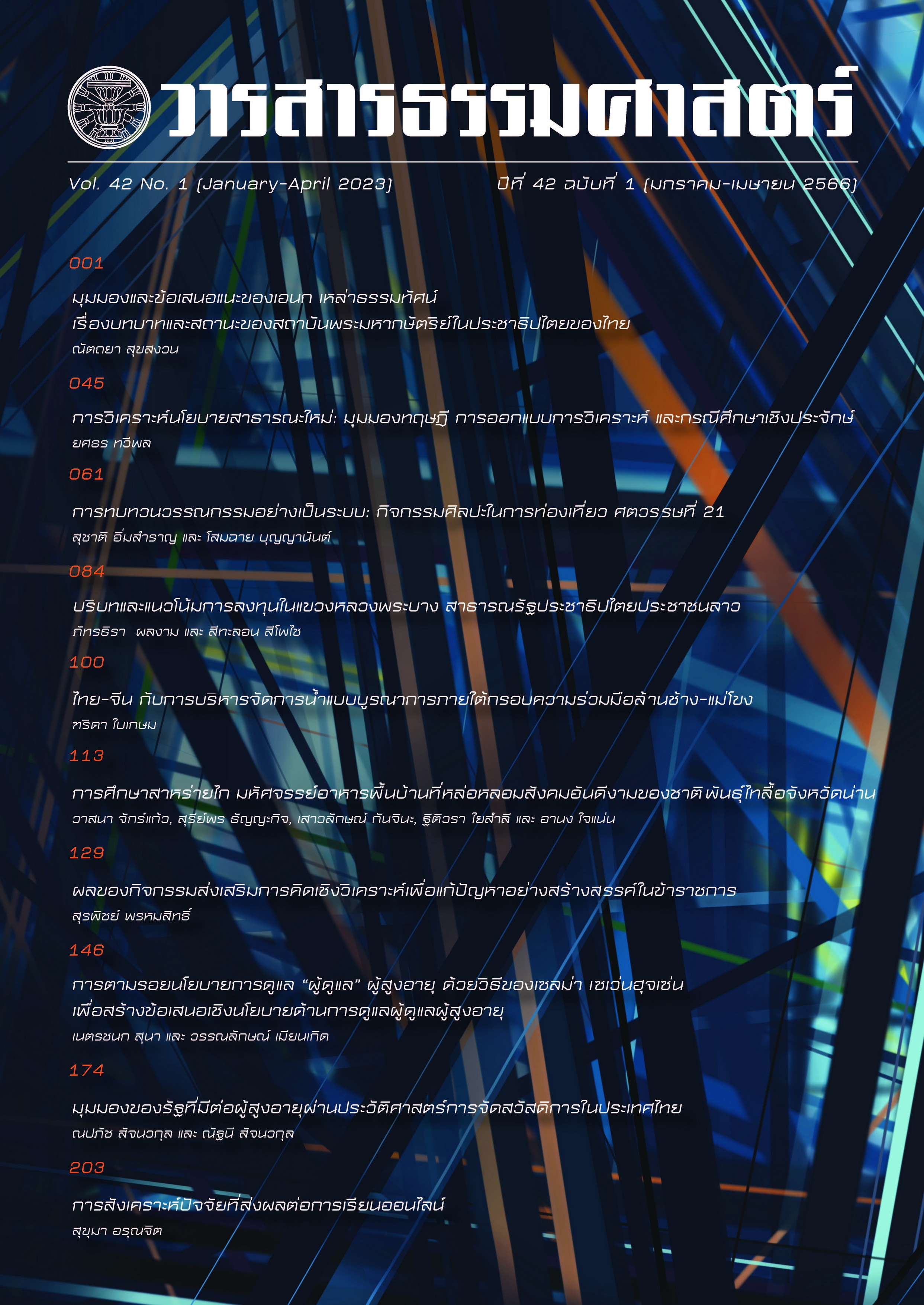A Systematic Review: Art Activities for Tourism in the 21st Century
Main Article Content
Abstract
The aim of this systematic review was to review and synthesize information and relationships in art activities in tourism in the 21st century. By studying the research articles in both national and international journals. The research articles were used in this study according to criteria from the database of the ThaiLis, Thaijo, Scopus, Proquest, Springer, Science Direct, Academic Search Ultimate, Google Scholar, ACM Digital Library, Base, Food Science Source, Google Scholar, and Taylor. The following are the selection criteria: 1) Published between 2017 – 2021 2) Search using these keywords: art activities, art learning, activities for tourism, art education 3) The target groups are tourists, children, youth and the elderly.
The results of the synthesis of 19 research articles and research reports found that 1) can be divided into three categories based on the research type: 2 experimental research, 12 qualitative research, and 5 development Research. If divided according to the content of the research consists of 10 art activities, 5 tourism activities, and 4 art education activities in tourism. 2) Art activities can be studied in the context of tourism. Because the objectives, sample group, research scope, activity type, and methodology are all related. As a result, research studies on Art activities in tourism in the twenty-first century. The objectives, methodology, activity context, and research scope must all be explicitly defined by the researcher.
Article Details
References
Chula Creative Tourism. (2563). ความหมายและกรณีศึกษาของการท่องเที่ยวเชิงสร้างสรรค์. https://cucreativetourismias.wordpress.com/28-2/
Nattanan Insong. (2561). พหุศิลปศึกษากับการศึกษาปฐมวัย. 6 ธันวาคม 2561. https://www.gotoknow.org/posts/658592
กระทรวงการท่องเที่ยวและกีฬา. (2561). MOU โครงการพัฒนาต้นแบบแหล่งท่องเที่ยวเพื่อคนทั้งมวลในพื้นที่พิเศษเมืองพัทยาและพื้นที่เชื่อมโยง (Tourism for All). https://www. mots.go.th/News-view.php?nid=10118
กระทรวงการท่องเที่ยวและกีฬา. (2563). COVID-19 กับผลกระทบต่อการท่องเที่ยวไทย (สถานการณ์การท่องเที่ยวของประเทศไทย) ไตรมาส 1/2563. Tourism Economic Review, 1(4), 1-64.
กระทรวงการท่องเที่ยวและกีฬา. (2563). CULTURE + CREATIVE TOURISM ท่องเที่ยว สร้างสรรค์ (สถานการณ์การท่องเที่ยวของไทย) ไตรมาส 4/2562. Tourism Economic Review, 1(3), 1-63.
การท่องเที่ยวแห่งประเทศไทย. (2564). 9 แนวโน้มใหม่ในอนาคตการท่องเที่ยว. กรุงเทพมหานคร.
กระทรวงศึกษาธิการ. (2560). หลักสูตรการศึกษาปฐมวัย พุทธศักราช 2560. กรุงเทพมหานคร: กระทรวงศึกษาธิการ.
การท่องเที่ยวแห่งประเทศไทย. (2564). 9 แนวโน้มใหม่ในอนาคตการท่องเที่ยว. กรุงเทพมหานคร.
กุลชาติ พันธุวรกุล. (2563). การจัดกิจกรรมศิลปะสร้างสรรค์ด้วยวัสดุเหลือใช้เพื่อส่งเสริมทักษะทางสังคมของเด็กวัยอนุบาล. วารสารครุศาสตร์สาร, 14(1), 130-145.
จิราพัทธ์ แก้วศรีทอง และ นิรัช สุดสังข์. (2562). ผลการใช้รูปแบบการจัดกิจกรรมศิลปะประดิษฐ์ เพื่อเสริมสร้างคุณภาพชีวิตในกลุ่มผู้สูงอายุ. Rajabhat J. Sci. Humanit. Soc. Sci. , 20(2), 136 - 144.
ณชนก หล่อสมบูรณ์ และ โสมฉาย บุญญานันต์. (2562). รูปแบบกิจกรรมศิลปะเพื่อส่งเสริมการ ท่องเที่ยวชุมชนเก่าในกรุงเทพมหานครและปริมณฑล. วารสารศิลปกรรมศาสตร์ มหาวิทยาลัยศรีนครินทรวิโรฒ, 23(1), 97-108.
ณัฐกาญจน์ จันทน์เนื้อไม้ และ อภิชาติ พลประเสริฐ (2562). การพัฒนาชุดกิจกรรมการเรียนรู้เพื่อส่งเสริมการเห็นคุณค่าศิลปะล้านนา. Veridian E-Journal, Silpakorn University, 12(5), 322-343.
ธีติ พฤกษ์อุดม. (2560). การพัฒนากิจกรรมศิลปะเพื่อส่งเสริมการเห็นคุณค่าของอัตลักษณ์ในงาน ศิลปหัตถกรรมภาคใต้สำหรับเยาวชน. วิทยานิพนธ์ปริญญามหาบัณฑิต, จุฬาลงกรณ์ มหาวิทยาลัย.
ธีระวัฒน์ เหมะจุฑา. (2563). โรคอุบัติใหม่ (EMERGING DISEASE). https://chulalongkorn hospital.go.th
นงลักษณ์ โพธิ์ไพจิตร และคณะ. (2563). การพัฒนาศักยภาพกิจกรรมการท่องเที่ยวเชิงสร้างสรรค์ ของกลุ่มชนไทยทรงดำ. กระแสวัฒนธรรม, 21(40), 53-64.
พิบูลย์ มังกร. (2562). การพัฒนาสมรรถนะการจัดการเรียนรู้สร้างสรรค์ศิลปะด้วยเทคนิคการลาก และการระบายเชิงบูรณาการในระดับประถมศึกษา. วารสารศิลปกรรมศาสตร์ มหาวิทยาลัยศรีนครินทรวิโรฒ, 23(2), 1-14.
ภัยมณี แก้วสง่า และ นิศาชล จำนงศรี. (2558). การท่องเที่ยวเชิงสร้างสรรค์ : ทางเลือกใหม่ของ การท่องเที่ยวไทย. Suranaree J. Soc. Sci., 6(1), 91-109.
วรรัตน์ เมธีวรกิจ. (2557). โรคอุบัติใหม่และโรคอุบัติซ้ำ. http://niah.dld.go.th/th/
วุฒิ วัฒนสิน. (2541). ศิลปะระดับมัธยมศึกษา. ปัตตานี : ฝ่ายเทคโนโลยีการศึกษา มหาวิทยาลัยสงขลานครินทร์.
สุดแดน วิสุทธิลักษณ์ และ คณะ. (2556). การท่องเที่ยวเชิงสร้างสรรค์ Creative Tourism. กรุงเทพมหานคร: องค์การบริหารการพัฒนาพื้นที่พิเศษเพื่อการท่องเที่ยวอย่างยั่งยืน (องค์การมหาชน).
สุดแดน วิสุทธิลักษณ์ และคณะ. (2556). คู่มือการท่องเที่ยวเชิงสร้างสรรค์ (Creative Tourism) องค์การบริหารการพัฒนาพื้นที่พิเศษเพื่อการท่องเที่ยวอย่างยั่งยืน (องค์การมหาชน) ร่วมกับ คณะสังคมวิทยาและมานุษยวิทยามหาวิทยาลัยธรรมศาสตร์. กรุงเทพมหานคร: องค์การบริหารการพัฒนาพื้นที่พิเศษเพื่อการท่องเที่ยวอย่างยั่งยืน (องค์การมหาชน).
สุพล พรหมมาพันธุ์. (2560). Disruptive Innovation เมื่อโลกใบใหม่ไม่ใช่ใบเดิมกับนวัตกรรมพลิกโลก. https://www.spu.ac.th/activities/15535
องค์การบริหารการพัฒนาพื้นที่พิเศษเพื่อการท่องเที่ยวอย่างยั่งยืน. (2563). ศิลปะ ศิลปิน การท่องเที่ยวเชิงสร้างสรรค์. กรุงเทพมหานคร.
อดิเทพ กำแพงเสรี. (2564). การสร้างกลยุทธ์การสื่อสารทางการตลาดเพื่อส่งเสริมกิจกรรมการท่องเที่ยวงานนิทรรศการ ศิลปะในจังหวัดนครราชสีมา. วารสารวิทยาลัยดุสิตธานี, 15(1), 417 - 430.
โอปอล์ รังสิมันตุชาติ และ ทิพาพร โพธิ์ศรี. (2564). การพัฒนากิจกรรมท่องเที่ยวเชิงวัฒนธรรมโดยการมีส่วนร่วมของชุมชนท้องถิ่นคอรุม จังหวัดอุตรดิตถ์. Journal of Modern Learning Development, 6(3), 355-369.
อภิชาติ พลประเสริฐ และ สริตา เจือศรีกุล. (2561). ผลการจัดกิจกรรมศิลปะเพื่อชุมชนใน มหกรรมรองเมืองเรืองยิ้ม. วารสารศิลปกรรมศาสตร์ มหาวิทยาลัยศรีนครินทรวิโรฒ, 22(1), 86-98.
Budiman, A. (2018). Art Education Tourism Model: Study on the Implementation of Art Education Tourism Model in Sanggar Saung Udjo-Indonesia. Advances in Social Science, Education and Humanities Research, 255, 178 - 182.
Budiman, A. (2020). The Effect of Architecture of Arts Education Tourism Towards Interest in Learning Arts for High School Students. Journal of Arts Research and Education, 20(2), 117 - 125.
Sua, L., Chenga, J., & Swanson, S. R. (2020). The impact of tourism activity type on emotion and storytelling: The moderating roles of travel companion presence and relative ability. Tourism Management, 81, 1 - 12.
Tamashiro, M. A. (2019). Creative Learning Kits for Physical Microworlds: Supporting the making of meaningful projects using lowcost materials. Proceedings of the 18 th ACM International Conference on Interaction Design and Children, 514–519.
Farsani, N. T. (2017). Traditional Crafts: a Tool for Geo-education in Geotourism. Geoheritage, 9(4), 1-8.
Fatmawati, N. (2018). Outdoor Study Activity by Utilizing Wonosoco Tourism Village as A Learning Resource of Social Studies. Journal of Educational Social Studies, 7(1), 90–97.
Remoaldo, P. (2020). Profling the participants in creative tourism activities: Case studies from small and medium sized cities and rural areas from Continental Portugal. Tourism Management Perspectives, 36, 1-12.
Andrade, P. D. (2020). Cultural Resistance To Covid-19:An Encyclopedia of Public Art for Artists and Tourism Publics?. Public Art Research, aims and networks, 2(2), 57-74.
Williams, R., & Debban, E. (2020). Learning From Traveling Sketchbooks Between Today's Students and Tomorrow's Teachers. Art Education, 73(2), 15-23. doi:10.1080/00043125.2019.1695484
Milfayetty, S. (2017). Innovation in Teaching and Learning Through Creative Art Model. European Journal of Social Sciences Education and Research, 4(4), 119-124.
Temiz, Z. (2018). Combining art activities and nature in pre-school education. Journal of Early Childhood Studies, 2(3), 556-570.

